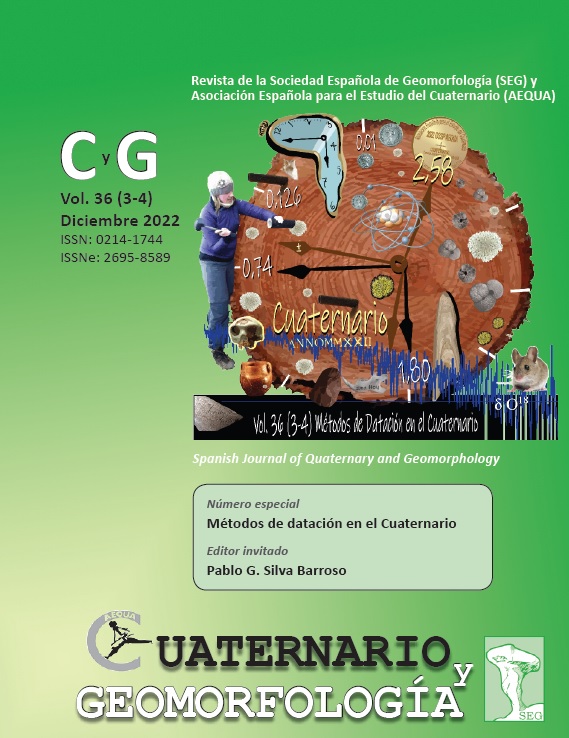Archaeomagnetic dating: Fundamentals, achievements and limitations
DOI:
https://doi.org/10.17735/cyg.v36i3-4.94093Keywords:
Earth's magnetic field, secular variation, thermoremanence, combustion structure, iron oxidesAbstract
Archaeomagnetism is a dating technique that allows dating the last heating of certain burnt archaeological and geological materials. The study of the thermoremanence recorded in some materials such as furnaces, hearths and volcanic rocks, allows us to reconstruct the variations in direction and/or intensity of the Earth's magnetic field over time through the development of regional curves and geomagnetic field models. These curves and models are powerful dating tools and most of them, including those developed for the Iberian Peninsula, span the last 3-4 millennia. Currently, it is possible to date the last use (heating) and potential abandonment of an archaeological combustion structure from the last 4,000 years with a temporal uncertainty that can vary, depending on factors, between ± 50 years and a few centuries. Here we report a synthesis of the technique´s fundamentals, the materials of interest and how to approach their sampling. The chronological range of application of the method and the factors determining its temporal precision are also discussed. Finally, a dating case of a peninsular prehistoric combustion structure is shown describing the steps followed to obtain an archaeomagnetic dating. The improvement and chronological extension of the technique notably depends on the interdisciplinary collaboration between geophysicists and archaeologists.
Downloads
References
Angelucci, D. E., Boschian, G., Fontanals, M., Pedrotti, A., Vergès, J. Mª. (2009). Shepherds and karst: the use of caves and rock-shelters in the Mediterranean region during the Neolithic. World Archaeology 41 (2), 191-214. https://doi.org/10.1080/00438240902843659
Brochier, J.E. (1983). Combustion et parcage des herbivores domestiques. Le point de vue du sédimentologue. Bulletin de la Société Préhistorique Française 80 (5),143-145.
Carrancho, Á., Villalaín, J.J., Pavon-Carrasco, F.J., Osete, M.L., Straus, L.G., Verges, J.M., Carretero, J.M., Angelucci, D.E., Gonzalez Morales, M.R., Arsuaga, J.L., Bermúdez de Castro, J.M., Carbonell, E. (2013). First directional European palaeosecular variation curve for the Neolithic based on archaeomagnetic data. Earth Planetary Science Letters 380, 124-137. http://dx.doi.org/10.1016/j.epsl.2013.08.031
Carrancho, Á. Villalaín, J.J., Vallverdú, J., Carbonell, E. (2016). Is it possible to identify temporal differences among combustion features in Middle Palaeolithic palimpsests? The archaeomagnetic evidence: a case study from level O at the Abric Romaní rockshelter (Capellades, Spain). Quaternay International, 417, 39–50. http://dx.doi.org/10.1016/j.quaint.2015.12.083
García-Redondo, N., Calvo-Rathert, M., Carrancho, Á., Goguitchaichvili, A., Iriarte, E., Blanco-González, A., Dekkers, M. J., Morales-Contreras, J., Alario-García, C. and Macarro-Alcalde, C. (2021). Further Evidence of High Intensity During the Levantine Iron Age Anomaly in Southwestern Europe: Full Vector Archeomagnetic Dating of an Early Iron Age Dwelling From Western Spain. Journal of Geophysical Research: Solid Earth, 126(9), e2021JB022614. https://doi.org/10.1029/2021JB022614
Gómez-Paccard, M., Chauvin, A., Lanos, P., McIntosh, G., Osete, M.L., Catanzariti, G., Ruiz-Martínez, V.C., Núñez, J.I. (2006). First archaeomagnetic secular variation curve for the Iberian Peninsula: comparison with other data from Western Europe and with global geomagnetic field models. Geochemistry Geophysics Geosystems 7, Q12001. https://doi.org/10.1029/2006GC001476
Gómez-Paccard, M., McIntosh, G., Chauvin, A., Beamud, E., Pavón-Carrasco, F.J. y Thiriot, J. (2012). Archaeomagnetic and rock magnetic study of six kilns from North Africa (Tunisia and Morocco). Geophysical Journal International, 189, 169-186. https://doi.org/10.1111/j.1365-246X.2011.05335.x
Herrejón-Lagunilla, Á. (2020). Estudios arqueomagnéticos en materiales quemados prehistóricos de la península ibérica. Aplicaciones geocronológicas y geoarqueológicas. Tesis Doctoral, Dpto. Física, Universidad de Burgos. 344 pp.
Jackson, A., Jonkers, A.R.T. and Walker, M.R. (2000). Four centuries of geomagnetic secular variation from historical records. Philosophical Transactions of the Royal Society of London A, 358, 957-990. https://doi.org/10.1098/rsta.2000.0569
Lanos, P. (2004). Bayesian inference of calibration curves, application to archaeomagnetism. In: Buck, C.E., Millard, A.R. (Eds.), Tools for Constructing Chronologies, Crossing Disciplinary Boundaries, Lecture Notes in Statistics 177. Springer-Verlag, London, pp. 43-82. https://doi.org/10.1007/978-1-4471-0231-1_3
Molina-Cardín, A., Campuzano, S. A., Osete, M. L., Rivero-Montero, M., Pavón-Carrasco, F. J., Palencia-Ortas, A., et al. (2018). Updated Iberian archeomagnetic catalogue: New full vector paleosecular variation curve for the last three millennia. Geochemistry, Geophysics, Geosystems, 19, 3637–3656. https://doi.org/10.1029/2018GC007781
Osete, M. L., Molina-Cardín, A., Campuzano, S. A., Aguilella-Arzo, G., Barrachina-Ibañez, A., Falomir-Granell, F., et al. (2020). Two archaeomagnetic intensity maxima and rapid directional variation rates during the Early Iron Age observed at Iberian coordinates. Implications on the evolution of the Levantine Iron Age Anomaly. Earth and Planetary Science Letters, 533, 116047. https://doi.org/10.1016/j.epsl.2019.116047
Pavón-Carrasco, F. J., Rodríguez-González, J., Osete, M. L., and Torta, J. M. (2011). A MATLAB tool for archaeomagnetic dating. Journal of Archaeological Science, 38, 408–19. https://doi.org/10.1016/j.jas.2010.09.021
Pavón-Carrasco, F.J., Osete, M.L., Campuzano, S., McIntosh, G., Martín-Hernández, F. (2015). Recent developments in Archeomagnetism: the story of the Earth's past magnetic field. In: "New Developments in Paleomagnetism Research" (L. V. Eppelbaum, Ed.). Nova Science Publishers. New York (USA). 99-158. ISBN: 978-1-63483-129-1.
Pavón-Carrasco, F. J., Campuzano, S. A., Rivero-Montero, M., Molina-Cardín, A., Gómez-Paccard, M., & Osete, M. L. (2021). SCHA.DIF.4k: 4,000 years of paleomagnetic reconstruction for Europe and its application for dating. Journal of Geophysical Research: Solid Earth, 126, e2020JB021237. https://doi.org/10.1029/2020JB021237
Tauxe, L. (2010). Essentials of Rock and Paleomagnetism. University of California Press (1st Edit.), 512 pp. ISBN: 9780520260313
Thébault, E., Gallet, Y. (2010). A bootstrap algorithm for deriving the archeomagnetic field intensity variation curve in the Middle East over the past 4 millennia BC. Geophysical research letters, 37(22). https://doi.org/10.1029/2010GL044788
Villalaín, J.J. (2016). La historia del campo magnético terrestre registrada en las rocas. Fundamentos del Paleomagnetismo. AEPECT, Enseñanzas de las Ciencias de la Tierra 24 (3), 261-274.


